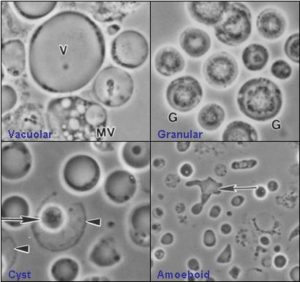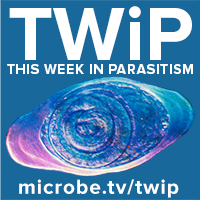
Four common forms of Blastocystis hominis
The triple TWiP solve the case of the Peace Corp Veteran with Eosinophilia, and discuss the genome sequence of the hyper-prevalent parasitic eukaryote Blastocystis.
Hosts: Vincent Racaniello, Dickson Despommier, and Daniel Griffin
Click arrow to play
Download TWiP #140 (58 MB .mp3, 95 minutes)
Subscribe (free): iTunes, RSS, email
Become a patron of TWiP.
Links for this episode:
- Genome diversity of Blastocystis (PLoS Biol)
- Photo credit
- Letters read on TWiP 140
This episode is brought to you by Blue Apron. Blue Apron is the #1 fresh ingredient and recipe delivery service in the country. Get $30 off your first delivery and FREE SHIPPING by going to blueapron.com/twip.
Case Study for TWiP 140
From Dr. Arthur Mumelo, northern Kenya. One-year-old girl. Brought by mother with skin lesions that developed a week prior. The lesions are five in total – on the forehead, neck, back, chest and right arm. The lesions look like boils/furuncles but keep changing size and appearance – like something is moving under the skin. They are painful and itchy. Child is breastfeeding well. No other complaints. Child was born at Nyahururu County Referral Hospital. Gets vaccinations at Melwa Health Centre (Rural), vaccinations are up to date. They live in a wooden house with a dirt floor, roofed with corrugated iron sheets. The house has two rooms. They sleep on raised beds. There is a big community dam in the neighborhood, with stagnant water throughout the year. They don’t use mosquito nets. They have reliable clean water supply from the government. They have one dog but the neighbors’ dogs also visit their compound and living area. They hang their clothes on the clothesline after washing; never dry their clothes on the grass. Clothes not hot-ironed. On Examination; Child is breastfeeding well, afebrile, no pallor, no jaundice, not in distress. Occipital lymphadenopathy; tender, mobile. Furuncles on the forehead, chest neck, back and right arm. They are 1-3cm in diameter and 0.5 cm high, tender, have a central punctum from which serosanguineous fluid is discharging. This is a rural health centre – the only labs done are a peripheral blood film – which showed increased eosinophils and neutrophils. HIV test – negative.
Send your case diagnosis, questions and comments to [email protected]
Music by Ronald Jenkees


Good morning from 13 Celsius Boston.
Please ask Dr. Griffin to listen to his statement at about 40:17 to 40;20 minutes. He made, perhaps, a Freudian slip when he referred to DEC, diethycarbamazine, as DIC, disseminated intravascular coagulation. I don’t think that is what he meant, As I recall, hypotension can occur when DIC is present, but that is now beyond my scope of practice.
As usual, most impressed by the medical students’ differentials and thoughtful presentations. They are inspiring!
,
As the season approaches, thankful for the wonderful worlds of microbiology that are made accessible, presented, explored and explained.
Best of health to all!